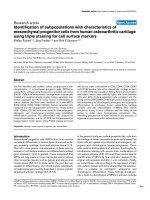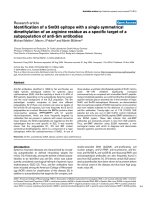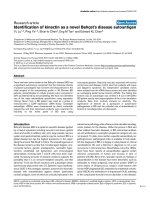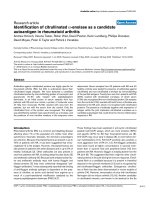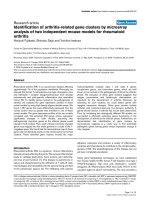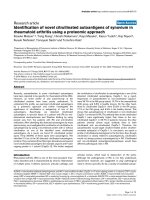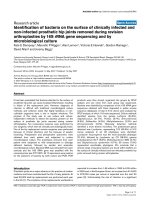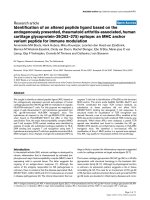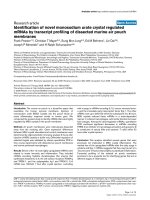Báo cáo y học: "Identification of a SmD3 epitope with a single symmetrical dimethylation of an arginine residue as a specific target of a subpopulation of anti-Sm antibodies" ppsx
Bạn đang xem bản rút gọn của tài liệu. Xem và tải ngay bản đầy đủ của tài liệu tại đây (553.74 KB, 11 trang )
Open Access
Available online />R19
Vol 7 No 1
Research article
Identification of a SmD3 epitope with a single symmetrical
dimethylation of an arginine residue as a specific target of a
subpopulation of anti-Sm antibodies
Michael Mahler
1
, Marvin J Fritzler
2
and Martin Blüthner
3
1
Director Development and Production, Dr. Fooke Laboratorien GmbH, Neuss, Germany
2
Professor of Medicine, Faculty of Medicine, University of Calgary, Calgary, Canada
3
Vice Director of Autoimmune Diagnostics, Laboratory of Prof. Seelig and colleagues, Karlsruhe, Germany
Corresponding author: Michael Mahler,
Received: 9 Aug 2004 Revisions requested: 26 Aug 2004 Revisions received: 31 Aug 2004 Accepted: 1 Oct 2004 Published: 10 Nov 2004
Arthritis Res Ther 2005, 7:R19-R29 (DOI 10.1186/ar1455)
http://arthrit is-research.com /content/7/1/R 19
© 2004 Mahler et al., licensee BioMed Central Ltd.
This is an Open Access article distributed under the terms of the Creative Commons Attribution License ( />2.0), which permits unrestricted use, distribution, and reproduction in any medium, provided the original work is cited.
Abstract
Anti-Sm antibodies, identified in 1966 by Tan and Kunkel, are
highly specific serological markers for systemic lupus
erythrematosus (SLE). Anti-Sm reactivity is found in 5–30% of
SLE patients, depending on the autoantibody detection system
and the racial background of the SLE population. The Sm
autoantigen complex comprises at least nine different
polypeptides. All of these core proteins can serve as targets of
the anti-Sm B-cell response, but most frequently the B and D
polypeptides are involved. Because the BB'Sm proteins share
cross-reactive epitopes (PPPGMRPP) with U1 specific
ribonucleoproteins, which are more frequently targeted by
antibodies that are present in patients with mixed connective
tissue disease, the SmD polypeptides are regarded as the Sm
autoantigens that are most specific to SLE. It was recently
shown that the polypeptides D1, D3 and BB' contain
symmetrical dimethylarginine, which is a component of a major
autoepitope within the carboxyl-terminus of SmD1. In one of
those studies, a synthetic dimethylated peptide of SmD1 (amino
acids 95–119) exhibited significantly increased
immunoreactivity as compared with unmodified SmD1 peptide.
Using immobilized peptides, we confirmed that the dimethylated
arginine residues play an essential role in the formation of major
SmD1 and SmD3 autoepitopes. Moreover, we demonstrated
that one particular peptide of SmD3 represents a more sensitive
and more reliable substrate for the detection of a subclass of
anti-Sm antibodies. Twenty-eight out of 176 (15.9%) SLE
patients but only one out of 449 (0.2%) control individuals
tested positive for the anti-SmD3 peptide (SMP) antibodies in a
new ELISA system. These data indicate that anti-SMP
antibodies are exclusively present in sera from SLE patients.
Thus, anti-SMP detection using ELISA represents a new
serological marker with which to diagnose and discriminate
between systemic autoimmune disorders.
Keywords: anti-Sm, autoantibody, ELISA, epitope, systemic lupus erythematosus
Introduction
Systemic rheumatic diseases are characterized by circulat-
ing autoantibodies to defined intracellular targets (for
review [1]). Historically, among the earliest of these autoan-
tibodies to be identified was anti-Sm, which was subse-
quently considered a serological hallmark of systemic lupus
erythematosus (SLE) [2]. Thus, anti-Sm antibodies have
been included among the American College of Rheumatol-
ogy (ACR) criteria for classification of this disease [3]. In
addition to autoantibodies that target the Sm complex, anti-
double-stranded DNA (dsDNA), anti-proliferating cell
nuclear antigen, anti-U1-RNP, anti-nucleosome, anti-his-
tone, anti-Ro/SS-A, anti-La/SS-B, anti-ribosomal RNP, and
anti-phospholipid antibodies are also frequently found in
sera from SLE patients [1]. Of interest, certain SLE-associ-
ated autoantibodies have been shown to be present before
the clinical onset of the disease and thus have high prog-
nostic value [4].
ACR = American College of Rheumatology; AMLI = Association of Medical Laboratory Immunologists; ANA = anti-nuclear antibody; CDC = Centers
for Disease Control and Prevention; CENP = centromere protein; dsDNA = double-stranded DNA; EBV = Epstein–Barr virus; ELISA = enzyme-linked
immunosorbent assay; MCTD = mixed connective tissue disease; NPV = negative predictive value; pI = isoelectric point; PPV = positive predictive
value; ROC = receiver operating characteristic; sDMA = symmetrical dimethylarginine; SLE = systemic lupus erythematosus; SMP = SmD3 peptide.
Arthritis Research & Therapy Vol 7 No 1 Mahler et al.
R20
On average, anti-Sm reactivity is found in 5–30% of
patients with SLE, although the specific frequency
depends on the detection system used and the racial and
genetic makeup of the SLE population [5,6]. The Sm
autoantigen is part of the spliceosomal complex that partic-
ipates in the splicing of nuclear pre-mRNA [7]. The complex
itself is comprised of at least nine different core polypep-
tides with molecular weights that range from 9 to 29.5 kDa
[8]: B (B1; 28 kDa), B' (B2; 29 kDa), N (B3; 29.5 kDa), D1
(16 kDa), D2 (16.5 kDa), D3 (18 kDa), E (12 kDa), F (11
kDa) and G (9 kDa). All of these core proteins can be tar-
gets of the anti-Sm immune response, but the most preva-
lent response is to the B and D polypeptides, which are
therefore considered the major antigens [8-10].
Because SmBB' share cross-reactive epitopes with U1-
specific RNPs, which are more frequently targeted by anti-
bodies that are present in patients with mixed connective
tissue disease (MCTD), SmD is regarded as the Sm
autoantigen that is most specific to SLE [11]. Within the
SmD family, the SmD1/D3 reactivity pattern is at least four
times more common than SmD1/D2/D3 recognition, with
immunoreactivity to SmD1 being the most dominant [11].
Several linear and conformational epitopes have been
mapped on the SmB and SmD proteins [12-14]. On SmD1
and SmBB' the major reactivity was found in the carboxyl-
terminal regions [13-15]. The epitope PPPGMRPP, which
occurs three times within the carboxyl-terminus of SmBB',
was shown to crossreact with other proline-rich structures
of spliceosomal autoantigens, including the U1-specific
RNPs, and of retroviral proteins such as HIV-1 p24gag
[16]. Follow-up studies and immunization experiments
revealed this motif to be consistently the earliest detectable
SmBB' epitope, indicating that it acts as a potential starting
point for epitope-spreading events associated with the
SmBB' molecule and SmD polypeptides [17,18].
A recent study [19] identified five linear epitopes on SmD2
and four on SmD3 that were distributed along the full
length of the molecules. All of these epitopes share basic
properties and are exposed on the surface of the protein,
rendering them antigenic [19]. One of the B-cell epitopes
on SmD3 (epitope 4; amino acids 104–126) exhibited
sequence similarity with an antigenic region from the SmD1
protein, and this may account for some cross-reactivity
[19]. For diagnostic purposes, a synthetic peptide corre-
sponding to the carboxyl-terminal domain of SmD1 was
used to develop an ELISA system with diagnostic sensitiv-
ities and specificities ranging from 36% to 70% and from
91.7% to 97.2%, respectively [6,20]. It was recently shown
that the polypeptides D1, D3 and BB' contain symmetrical
dimethylarginine (sDMA), which constitutes a major
autoepitope within the carboxyl-terminus of SmD1 [21,22].
The aims of the present study were to develop a peptide-
based ELISA system for the detection of anti-Sm antibod-
ies and to evaluate the diagnostic properties of the peptide
assay. Moreover, epitope-mapping experiments were per-
formed to shed more light on the controversial findings of
the importance of sDMA residues within the SmD1 and
SmD3 sequences and their relationship to SLE.
Methods
Patients and sera evaluated
Sera (n = 628) were collected from patients suffering from
SLE (n = 176), rheumatoid arthritis (n = 86), Sjögren's syn-
drome (n = 24), MCTD (n = 26), systemic sclerosis (n =
26) and polymyositis/dermatomyositis (n = 13), as well as
from patients with overlap syndromes (n = 8). All patients
were classified according to the ACR criteria for each dis-
ease [3,23-27]. Clinical, serological and demographic data
were available from 101 SLE patients (SLE panel 1). This
cohort contained 34 samples from white patients, 51 from
black patients, five from hispanic patients, one from an east
Indian patient, and one from an oriental patient. The racial
background of four patients was not known. Of these
patients, 13 were male and 86 female (in two the sex was
unknown), and the mean age was 40 years (range 16–80
years). The sera were kindly provided by Drs R Mierau and
E Genth (Rheumaklinik Aachen, Aachen, Germany), Prof.
Dr MJ Fritzler (University of Calgary, Calgary, Canada) and
by Labor Limbach (Heidelberg, Germany).
To assess further the assay specificity, we analyzed a
group of sera from patients with infectious diseases (n =
77), including hepatitis C virus (n = 30), cytomegalovirus (n
= 22) and Epstein–Barr virus (EBV; n = 25) infections, as
well as from 192 healthy blood donors. All sera were stored
at -80°C until use. For the epitope-mapping study, a panel
of five sera (all from SLE patients) containing anti-Sm anti-
bodies that were available in greater quantities preselected
by ELISA (Varelisa
®
Sm; Pharmacia Diagnostics, Freiburg,
Germany) was used. Autoimmune sera with antibody spe-
cificities other than anti-Sm were selected as negative con-
trols, including anti-RNP, anti-SS-A (Ro), anti-SS-B (La),
anti-PM/Scl, anti-centromere protein (CENP) and anti-Scl-
70.
Serological characterization of randomly selected
systemic lupus erythematosus sera
The sera from SLE patients represented in panel 1 with
clinical, serological and demographic data, as well as the
autoimmune controls, were tested for autoantibodies to his-
tones (cutoff 30 U/ml), dsDNA (cutoff 55 U/ml) and the Sm
complex (cutoff 15 U/ml, or ratio 1) using quantitative
ELISA tests (Varelisa
®
; Pharmacia Diagnostics; catalog
nos 14196, 16296 and 16496). SLE sera and samples
that exhibited unexpected results were also measured
using the semiquantitative Split anti-nuclear antibody
Available online />R21
(ANA) profile (Pharmacia Diagnostics; cutoff ratio 1). The
latter assay contains the autoantigens U1-68 kDa, U1-A,
U1-C, SmBB', SmD, Ro-52, Ro-60 and La. All ELISAs were
performed in accordance with the manufacturer's
instructions.
Reference serum panels
The US Centers for Disease Control and Prevention (CDC)
ANA serum panel [28] and the Association of Medical Lab-
oratory Immunologists (AMLI) samples [29] were used to
characterize the new Sm peptide-based immunoassay.
Epitope-mapping with immobilized oligopeptides
The published sequences of SmD1 (P13641) and SmD3
(P43331) were used to synthesize overlapping 15 mer
peptides with a pipetting robot (ASP222; Abimed, Langen-
field, Germany), in accordance with the protocol described
by Gausepohl and Behn [30-33]. The carboxyl-terminal
extensions of both polypeptides were synthesized with an
offset of two amino acids (13 amino acid overlap). Each
arginine-containing peptide was synthesized as three vari-
ants, one with natural arginine, one with sDMA and one
with asymmetrical dimethylarginine at the respective posi-
tions. In addition, a highly reactive SmD3 peptide was syn-
thesized with certain combinations of natural arginine and
sDMA. Following completion of the peptide synthesis, non-
specific binding sites were blocked by overnight incubation
of the membranes in blocking buffer (2% milk in Tris-buff-
ered saline) at room temperature. After one washing step
for 5 min, the membranes were incubated with serum sam-
ples diluted 1:100 in blocking buffer for 2 hours at room
temperature. Unbound antibodies were removed by three
washing steps in Tris-buffered saline–0.2% Tween. The
membranes were incubated for 75 min at room tempera-
ture in a peroxidase-conjugated goat-anti-human IgG anti-
body (Dianova, Hamburg, Germany) that was diluted
1:5000 in blocking buffer. Unbound secondary antibodies
were removed by three changes of Tris-buffered saline.
Finally, bound antibodies were visualized using the ECL
detection system (Amersham Bioscience, Freiburg,
Germany).
Synthesis of the SmD3 peptide
The candidate SmD3 peptide (SMP) identified in the
epitope-mapping study (
108
AARG sDMA
GRGMGRGNIF
122
) was synthesized with an additional
cysteine residue at the carboxyl-terminus, in accordance
with Fmoc-chemistry at the Peptide Specialty Laboratories
GmbH (Heidelberg, Germany). sDMA (Ref. B-3345.0001)
was purchased from Bachem AG (Bubendorf, Switzerland)
and used for synthesis. Crude fraction was purified using
high-performance liquid chromatography. Quality and
purity of the peptide was assessed by mass spectrometry
and analytical high-performance liquid chromatography.
The molecular mass was found to be 1708.1 Da (average;
monoisotopic mass 1706.9), and a purity in excess of 95%
was identified.
SmD3 peptide ELISA
Microtiterplates (Maxisorb, Nunc, Denmark) were coated
with the uncoupled 16 mer peptide at a concentration of
2.5 µg/ml in phosphate-buffered saline (pH = 7.6). After an
incubation time of 15 hours at 15°C, the plates were
blocked with 1% bovine serum albumin in phosphate-buff-
ered saline for 30 min at room temperature. The assay was
performed in accordance with the general protocol for the
Varelisa
®
system (Pharmacia Diagnostics). In brief, follow-
ing a prewashing (300 µl/well) step, the serum samples
were diluted 1:101 in sample buffer (phosphate-buffered
saline, containing bovine serum albumin and Tween),
added to the wells and then incubated for 30 min (100 µl/
well). After three washing steps (300 µl/well), horseradish
peroxidase conjugated anti-human IgG was added and
incubated for 30 min (100 µl/well). Visualization was done
by incubation in 3,3',5,5'-tetra-methyl benzidine substrate
for 10 min (100 µl/well), and the reaction was terminated
by adding 50 µl stop solution (0.5 mol/l H
2
SO
4
) to each
well. All steps were carried out at room temperature.
A standard curve was developed using a highly reactive
index serum that bound the SmD3 peptide and had a
defined reactivity of 40,000 U/ml. The curve was plotted at
six standard points (0, 3, 7, 16, 40 and 100 U/ml). Each
serum sample was tested in duplicate and serum samples
that had reactivity above the assay range were serially
diluted to 1:500, 1:2500, 1:12,500 and 1:62,500.
To define further the assay characteristics, 192 normal
human sera were assayed in accordance with the instruc-
tions for use. Blood donors exhibited a reactivity range of
0.4–11.5 U/ml, a mean value of 2.2 U/ml and a standard
deviation of 1.2 U/ml. The cutoff was set at 13 U/ml follow-
ing receiver operating characteristic (ROC) analysis. Posi-
tive predictive values (PPVs) and negative predictive values
(NPVs) were calculated at different cutoff values using
Analyse-it software (Version 1.62; Analyse-it Software Ltd,
Leeds, UK).
Precision and reproducibility
Measurements of imprecision (interassay and intra-assay
variability) were taken over four and six replicates, respec-
tively. To assess the precision of the anti-SMP ELISA, suit-
able anti-Sm sera – a low value sample (L), a medium value
sample (M) and a high value sample (H) – were assayed in
five independent tests on one day (interassay) or in a single
run (intra-assay). For within-run precision, the L, M and H
samples were measured in six replicates on one solid
phase. The precision data were calculated using analysis of
variance.
Arthritis Research & Therapy Vol 7 No 1 Mahler et al.
R22
Linearity
Linearity was analyzed by testing dilutions (1:1, 2:3, 1:2,
1:4, 1:8, 1:16, 1:32) of the highest standard point (S6) and
of the high value sample from the precision analysis (H). For
each dilution point, a ratio of the measured reactivity to the
expected value was calculated, and 1 was subtracted from
this quotient.
Results
Epitope fine mapping of the carboxyl-terminal
extensions of SmD1 and SmD3
To evaluate the effect of arginine dimethylation on the anti-
genicity of SmD1 and SmD3 and to localize relevant
epitopes on both polypeptides, a panel of anti-Sm sera was
tested for reactivity with peptide arrays (15 mer, two offset)
covering the carboxyl-terminal region of SmD1 (P13641)
and SmD3 (P43331). The results show that dimethylation
of arginine residues significantly affects the binding of anti-
Sm antibodies to carboxyl-terminal SmD1 and SmD3 pep-
tides (Fig. 1). All anti-Sm sera exhibited increased binding
to SmD1 peptides containing sDMA as compared with
those containing unmethylated arginine (Fig. 1a). In partic-
ular, peptides that exclusively consist of glycine and sDMA
repeats exhibited strong reactivity with the antibodies (pep-
tide nos 9, 10 and 11). Nevertheless, SmD1 peptides con-
taining sDMA represent a rather unspecific substrate for
anti-Sm antibodies because they were also bound by sera
that contained anti-centromere antibodies. Interestingly,
those anti-centromere antibodies also bound to peptides
containing the asymmetrical form of DMA but to a lesser
extent.
Binding experiments with peptides derived from SmD3
yielded similar results. Only SmD3 peptides containing
sDMA reacted with anti-Sm antibodies, confirming the
importance of the symmetrical dimethylation of arginine res-
idues (Fig. 1b). In contrast to SmD1, none of the control
sera reacted with SmD3 derived peptides, which reflects
high binding specificity. One particular peptide (no. 77;
108
AA sDMA G sDMA G sDMA GMG sDMA GNIF
122
)
was strongly recognized by three out of five anti-Sm sera.
Using a mutational analysis in which arginine residues of
peptide no. 77 (
108
AARGRGRGMGRGNIF
122
) were suc-
cessively replaced by sDMA, we were able to show that a
particular peptide with a single dimethylated arginine resi-
due at position 112 exhibited immunoreactivity with all of
the five anti-Sm sera but not with the control sera (Fig. 1c).
Thus, by introducing only one sDMA and at a defined posi-
tion (amino acid 112) in SmD3, the sensitivity of binding to
this peptide (
108
AARG sDMA GRGMGRGNIF
122
; SMP)
was remarkably increased without loss in specificity. This
candidate peptide was subsequently synthesized as a sol-
uble antigen and used as a substrate in ELISA.
Immunoserological characterization of the systemic
lupus erythematosus patient cohort
In order to characterize the SLE cohort with regard to
autoantibody profiles, 101 SLE patient sera were tested for
U1-68 kD, U1-A, U1-C, SmBB', SmD, Ro-52/SS-A, Ro-60/
SS-A, La/SS-B, histone, dsDNA and β
2
-glycoprotein I reac-
tivity. The prevalences of the different autoantibodies were
as follows: 15.8% for U1-68, 24.8% for U1-A, 25.7% for
U1-C, 21.8% for SmBB', 15.8% for SmD, 21.8% for Ro-
52, 47.5% for Ro-60, 21.8% for La, 37.6% for histone,
51% for dsDNA and 17% for β
2
-glycoprotein I. The preva-
lences were therefore consistent with those in previous
studies [1,6]. Thus, with regard to their autoantibody pro-
files, our SLE cohort appears to be representative of SLE
patients in general.
Anti-SmD3 peptide ELISA
A 15 amino acid soluble peptide exhibited highest sensitiv-
ity and specificity in the SPOT assay (
108
AARG sDMA
GRGMGRGNIF
122
) was, for coupling purposes, synthe-
sized with an additional cysteine at the carboxyl-terminus.
Nevertheless, the uncoupled 16 mer peptide was subse-
quently used to develop an ELISA system based on the
general protocol of the Varelisa
®
tests (Pharmacia
Diagnostics).
Assay performance characteristics
To evaluate the performance of the assay, the precision,
reproducibility and linearity were analyzed. The intra-assay
and interassay variabilities (coefficient of variation in %) for
three samples ranged from 1.82% to 6.52% and from
2.27% to 7.42%, respectively. Even after five serial dilu-
tions, two samples exhibited a linear range of reactivity
(<20% deviation). The cutoff was defined by ROC analysis,
performed with SLE and control sera. The assay perform-
ance characteristics of the new anti-SMP test are summa-
rized in Fig. 2, including intra-assay and interassay
variability (Fig. 2a), linearity (Fig. 2b), and ROC analysis,
PPV, NPV and efficiency (Fig. 2c).
To determine the cutoff, the focus was set to yield a high
specificity and a technical cutoff was defined at 13 U/ml.
Sera from 176 SLE patients, 181 other autoimmune
patients, 77 patients with infectious diseases, and from
192 normal donors were analyzed in the new ELISA system
(Table 1). Twenty-eight SLE patients (15.9%) tested posi-
tive for anti-SMP antibodies, exhibiting a significantly
increased reactivity of up to 1190 U/ml with a mean value
of 43.0 U/ml (standard deviation 160.2 U/ml). Sera from
patients with related disorders had significantly reduced
reactivity (mean 3.36 U/ml). Only one patient in the rheuma-
toid arthritis group had a positive test result (24.6 U/ml).
None of the remaining control individuals, including
patients suffering from systemic sclerosis (n = 26), polymy-
ositis/dermatomyositis (n = 13), MCTD (n = 26), Sjögren's
Available online />R23
syndrome (n = 24), or infectious diseases (n = 77), exhib-
ited reactivity to the SmD3 peptide. The serum samples
from patients with infectious diseases demonstrated
reduced reactivity (mean 0.67 U/ml; top value 3.3 U/ml),
even when compared with sera from healthy donors (mean
2.21 U/ml; top value 11.5 U/ml). The highest assay value in
the infectious disease sera was found in patients with EBV
infection (3.3 U/ml).
In summary, 28 samples in the SLE cohort (n = 176) and
only one serum sample from the control group (n = 449;
0.2%) tested positive. This resulted in a diagnostic specifi-
city of 99.8% and a sensitivity of 15.9%. PPV, NPV and
diagnostic efficiency were calculated at 96.6%, 75.3% and
76.3%, respectively (Fig. 2c). These data indicate that,
within the assay parameters used here, anti-SMP antibod-
ies appear to be exclusively present in sera from SLE
patients. Apart from anti-SMP reactivity, it is interesting to
note that the positive rheumatoid arthritis serum contained
high titres of antibodies to U1-RNPs 68 kDa (ratio 4.5), U1-
C (ratio 9.4) and histone (133.8 U/ml). Anti-SmBB'and
anti-SmD titres, as determined by ELISA, were elevated
Figure 1
Epitope analysis of SmD1 and SmD3Epitope analysis of SmD1 and SmD3. Carboxyl-terminal regions of (a) SmD1 and (b) SmD3 were synthesized as peptide arrays (15 mers; two
amino acids offset) and probed with patient sera. Each arginine containing peptide was synthesized as three variants, one with natural arginine (R),
one with symmetrical dimethylarginine (sDMA) and one with asymmetrical dimethylarginine (asDMA) at the respective positions. In addition, a highly
reactive SmD3 peptide was synthesized with certain combinations of natural arginine and sDMA. A significant effect of dimethylation of arginine res-
idues on the antigenicity of SmD derived peptides was observed (black squares indicate strong reactivity; white indicate no reactivity). Binding of an
anti-Sm negative serum sample (Varelisa
®
Sm) that contained anti-centromere antibodies (ACA) could be observed with SmD1 but not with SmD3
peptides. Thus, the immunoreactive peptide no. 77 was further tested in (c) a replacement experiment. The SmD3 peptide exhibited exclusive reac-
tivity with the Sm-positive sera.
Arthritis Research & Therapy Vol 7 No 1 Mahler et al.
R24
when compared with controls, but they were still below the
cutoff values. No reactivity could be found to U1-A, Ro-52,
Ro-60, La, dsDNA, or β
2
-glycoprotein.
Correlation with other autoantibodies
A statistical evaluation was performed using sera from a
cohort of 101 patients with clinically defined SLE to evalu-
ate correlations between anti-SmD3 peptide antibodies
and other autoantibodies. Significant correlations were
found with dsDNA (P = 0.0058, χ
2
= 7.6), U1-68 (P <
0.0001, χ
2
= 15.42), U1-A (P < 0.0001, χ
2
= 25.49), U1-
C (P < 0.0001, χ
2
= 18.05), SmBB' (P < 0.0001, χ
2
=
24.04) and SmD (P < 0.0001, χ
2
= 38.76), but not to his-
tone (P = 0.0259, χ
2
= 4.96), La (P = 0.8747, χ
2
= 0.02),
Ro-52 (P = 0.4034, χ
2
= 0.7), Ro-60 (P = 0.0143, χ
2
=
6.0) and β
2
-glycoprotein antibodies (P = 0.3819, χ
2
=
0.74; Table 2). When reactivity with components of the Sm
complex was evaluated, five samples of the clinically
defined SLE patients (n = 101) reacted with the purified
SmD antigen, but not with SMP. The remaining 11 SmD
positive sera (68.8%) also tested positive in the new anti-
SMP ELISA. Interestingly, among the patients studied we
found four (nos 89, 92, 20627 and 9811) who fulfilled SLE
criteria and were all anti-SmD negative, but exhibited anti-
SMP reactivities of 15.4, 21.3, 41.3 and 13.9 units,
respectively.
Correlation with racial and clinical parameters
When correlating autoantibody specificities with race,
there was a statistically significant association of autoanti-
bodies to U1-68 kDa (P = 0.002), U1-A (P < 0.0001), U1-
C (P = 0.0002), SmBB' (P = 0.0004), dsDNA (P =
0.0128) and SmD (P = 0.0002) with black race among
SLE patients. There was no statistically significant associa-
tion of other autoantibody specificities, including SmD3
peptide (P = 0.0253), Ro-52 (P = 0.8023), Ro-60 (P =
0.0399), La (P = 0.7137) and histones (P = 0.9831), with
the race of the patients under investigation (data not
shown). In addition, there was no significant correlation of
SMP reactivity with renal (P = 0.2810) or central nerve sys-
tem involvement (P = 0.5066).
Reference panels
The CDC and the AMLI reference panels for ANA were
evaluated using the new SMP ELISA. Increased titres were
found in ANA 1 (10.3 U/ml) and ANA 5 (910 U/ml) from the
CDC panel and in samples I (1420 U/ml) and J (13.9 U/ml)
from the AMLI panel [28,29] (Table 3).
Discussion
In the present study we analyzed the anti-Sm immune
response directed toward the Sm antigens D1 and D3,
which are considered SLE-specific autoantigens [11].
Using immobilized peptides prepared by the SPOT tech-
nology, it was shown that symmetric dimethylation of
Table 1
Results of ELISA using SmD3 peptide with systemic lupus erythematosus and various control sera
Sera (n) Number (%) of anti-SMP positive sera Mean value (U/ml) Top value (U/ml)
SLE (176) 28 (15.9) 43.0 1190.0
Rheumatic diseases (181) 1 (0.6) 2.2 24.6
RA (86) 1 (1.2) 1.6 24.6
pSS (24) 0 1.9 3.9
MCTD (26) 0 3.1 12.8
SSc (26) 0 2.4 4.3
PM/DM (13) 0 2.8 9.6
Overlap syndromes (8) 0 2.1 3.6
Infectious diseases (77) 0 0.67 3.3
HCV (30) 0 0.42 1.1
CMV (22) 0 0.8 3.2
EBV (25) 0 0.78 3.3
Healthy individuals (192) 0 2.21 11.5
CMV, cytomegalovirus; EBV, Epstein – Barr virus; HCV, hepatitis C virus; MCTD, mixed connective tissue disease; PM/DM, polymyositis/
dermatomyositis; pSS, primary Sjögren's syndrome; RA, rheumatoid arthritis; SLE, systemic lupus erythematosus; SMP, SmD3 peptide; SSc,
systemic sclerosis.
Available online />R25
arginine residues plays an important role in the B-cell
epitope recognition of both autoantigens. This observation
is in accordance with the findings of Brahms and
coworkers [21] but it is not in keeping with those of Rieme-
kasten and colleagues [20]. In addition, we found the spe-
cificity of antibody binding to SmD3 peptides to be higher
than that to SmD1 peptides, both of which were prepared
using the SPOT method.
McClain and colleagues [19] described four antigenic
regions on SmD3, of which antigenic region 4 encom-
passes amino acids 104–126. In their study, peptides syn-
thesized on pins were subjected to analysis without using
the modified form of arginine. In our study, we found reac-
tivity within this region only when natural arginine was
replaced by sDMA. These apparently contradictory results
might be explained by the use of different sera or methol-
ogy, and/or by the different peptide length used in the two
studies. Three out of five of our sera specifically recognized
the peptide
108
AA sDMA G sDMA G sDMA GMG sDMA
GNIF
122
. Interestingly, the dimethylation of only one
arginine at a defined position (amino acid 112) was able to
increase further the sensitivity of this particular peptide
without loss of specificity.
Although it has been shown that all arginine residues within
the peptide
108
AA sDMA G sDMA G sDMA GMG sDMA
GNIF
122
become dimethylated in vivo, it is unclear whether
the identified peptide with single dimethylation occurs in
vivo and thus serves as the triggering epitope, or rather
whether it represents an artificial structure that is more suit-
able for in vitro assays [21].
Fewer than 20 proteins have been identified during the
past 40 years as containing dimethylated arginines [34].
The two major catalyzing enzymes of this reaction are the
type I and type II protein arginine methyltransferases, which
preferentially methylate arginines located in RG clusters.
Recently, however, using arginine methyl-specific antibod-
ies and HeLa cell extracts, it was shown that more than 200
proteins contained symmetrically dimethylated arginines;
among these were a remarkable number of known autoan-
tigens [34]. Further studies are necessary to screen known
autoantigens containing dimethylated arginine residues for
epitopes.
Based on data from epitope analysis, we used a candidate
peptide (
108
AARG sDMA GRGMGRGNIF
122
) to develop
an ELISA system. The new anti-Sm assay (anti-SMP) had a
sensitivity of 15.9% and a specificity of 99.8% for SLE,
resulting in a high PPV (96.6%) and NPV (75.3%), and a
remarkable diagnostic efficiency of 76.3%. Therefore, this
test appears to offer a new approach to serological evalua-
tion and diagnosis of SLE.
Figure 2
Assay performance characteristics of the anti-SmD3 peptide (SMP) assayAssay performance characteristics of the anti-SmD3 peptide (SMP)
assay. (a) Intra-assay and interassay variability, (b) linearity, and (c)
receiver operating characteristic analysis. The intra-assay and inte-
rassay variability, expressed as coefficient of variation in percentage
(CV%), of three samples ranged from 1.82 to 6.52% and from 2.27 to
7.42%, respectively. Serial dilution series of two samples with high
titres of anti-Sm antibodies (S6 and H) exhibited a linear binding
response (<20% deviation). Definition of the cutoff, using receiver
operating characteristic (ROC) analysis, was performed with SLE and
control sera.
Arthritis Research & Therapy Vol 7 No 1 Mahler et al.
R26
Because no international 'gold standard' is available for
detection of anti-Sm antibodies, we compared results with
the new peptide-based ELISA with the results of an anti-
Sm ELISA using purified Sm antigen (Varelisa
®
Sm; Phar-
macia Diagnostics). Using this approach, we found compa-
rable sensitivities but significant differences in the
specificity. The specificity of the conventional ELISA (88%)
was significantly lower than the specificity of the new pep-
tide-based assay (99.8%; data not shown). Further studies
are in progress to compare the assay performance of the
anti-SMP assay with that of other commercially available
anti-Sm immunoassays. For epitope-mapping, anti-Sm sera
from SLE patients were preselected, based on ELISA
results (Varelisa
®
Sm). That this selection method might
have affected the results of epitope-mapping cannot be
excluded. Nevertheless, the high sensitivity and specificity
of the SmD3 peptide with a single dimethylated arginine
could be confirmed using the soluble peptide in ELISA.
Evaluation of the biochemical properties of the identified
Sm epitopes suggested that the isoelectric point (pI) of the
peptide can be regarded as a predictor of antigenicity on
the Sm complex. On U1-RNP-A, SmB' and SmD1, the aver-
age pI of antigenic regions was 10.4 (nonantigenic 6.0)
and on SmD2 and SmD3 the pIs were 9.0 or higher [19].
These findings fit well with the observed pI (>12.88) of the
SMP. Further investigation is warranted to determine
whether the basic character of the epitope simply
increases the probability of surface exposure of these
regions and thus accessibility for immune recognition.
Epstein–Barr virus, Epstein–Barr virus nuclear antigen 1
and anti-SmD antibodies
Epitope-mapping studies on SmD1 have identified an
epitope motif (amino acids 95–119) that crossreacts with
a homologous sequence (amino acids 35-58) of the EBV
nuclear antigen 1 [35,36]. A more recent study showed
that this epitope also crossreacts with a homologous
region of SmD3 containing glycine and arginine repeats
Table 2
Association between anti-SmD3 peptide positivity and other autoantibody species in systemic lupus erythematosus
Autoantibody to
U1-68 kD U1-A U1-C SmBB' SmD Ro-52 Ro-60 La histone dsDNA β
2
-
Glycoprotein
SMP positive 8/16 12/25 11/26 11/22 11/16 5/22 12/48 4/22 10/38 13/51 4/16
Percentage 50% 48% 42.3% 50% 68.8% 22.7% 25% 18.2% 26.3% 25.5% 25%
P <0.0001 <0.0001 <0.0001 <0.0001 <0.0001 0.4034 0.0143 0.8747 0.0259 0.0058 0.3891
χ
2
statistic 15.42* 25.49* 18.05* 24.04* 38.76* 0.7 6.0 0.02 4.96 7.6* 0.74
* χ
2
test: statistically significant (χ
2
> 7).
Table 3
Results of the reference sera from the CDC and AMLI in the new anti-SmD3 peptide ELISA
Sample ID U/ml Sample ID U/ml Diagnosis
ANA 1 10.3 SLR Research A 2.5 CREST
ANA 2 1.4 SLR Research B 2.9 Scl
ANA 3 1.9 SLR Research D 2.8 MCTD
ANA 4 2.5 SLR Research E 3.1 SS, SLE
ANA 5 910.0 SLR Research F 1.5 PM
ANA 6 3.1 SLR Research G 4.5 SS
ANA 7 0.0 SLR Research I 1420.0 SLE
ANA 8 0.1 SLR Research J 13.9 SLE
ANA 9 1.7 SLR Research K 0.0 HD
ANA 10 0.5 SLR Research L 0.2 HD
AMLI, Association of Medical Laboratory Immunologists; CDC, Center for Disease Control and Prevention; CREST, calcinosis cutis, Raynaud's
phenomenon, esophageal dysfunction, sclerodactyly and telangiectasia; HD, healthy donor; MCTD, mixed connective tissue disease; PM,
polymyositis; Scl, scleroderma; SLE, systemic lupus erythematosus; SS, Sjögren's syndrome.
Available online />R27
(RGRGRGMGR) [19]. It is also evident that GPRR (amino
acids 114–119 on SmD1) represents a common crossre-
active autoepitope motif, which is present not only on EBV
nuclear antigen 1, but also on a variety of autoantigens
including CENP-A, CENP-B, CENP-C, SmBB', SmD1 and
Ro-52, to name but a few [30]. Thus, patients suffering
from infectious mononucleosis or SLE-related disorders
may have a positive carboxyl-terminal SmD1 or SmD3
ELISA that might be regarded as a false-positive result. Of
interest, several studies have suggested an influence of
EBV on the development of SLE-like conditions [37,38].
Among the 25 EBV disease controls we evaluated, we
found no false-positive samples, confirming the suggested
high specificity of the anti-SMP assay. Therefore, we con-
sider the use of EBV-positive sera with high titres of EBV-
associated antibodies to be important reagents for devel-
oping highly specific and reliable anti-SmD immunoassays.
Unfortunately, other investigators did not include an EBV
patient group in the evaluation of anti-Sm antibody assays
[20].
Correlations with other autoantibodies
Coincident reactivity with dsDNA and Sm antigens has
been reported by several authors [39-41]. Although in
those studies full-length SmD was used, in our investiga-
tion there was also a correlation of anti-dsDNA and anti-
SMP reactivity (P = 0.0058, χ
2
= 7.6). Apart from DNA we
found also a positive correlation of anti-SMP antibodies
with U1-68 (P < 0.0001, χ
2
= 15.42), U1-A (P < 0.0001,
χ
2
= 25.49), U1-C (P < 0.0001, χ
2
= 18.05), SmBB' (P <
0.0001, χ
2
= 24.04) and SmD (P < 0.0001, χ
2
= 38.76),
but not to histone (P = 0.0259, χ
2
= 4.96), La (P = 0.8747,
χ
2
= 0.02), Ro-52 (P = 0.4034, χ
2
= 0.7), Ro-60 (P =
0.0143, χ
2
= 6.0) and β
2
-glycoprotein (P = 0.3819, χ
2
=
0.74) antibodies. Whether the observed associations are
caused by cross-reactivity or by different autoantibody spe-
cies that often occur simultaneously remains unclear. Pre-
liminary results of inhibition experiments have shown no
inhibiting effect of the SmD3 peptide on the binding of anti-
Sm antibodies to the native Sm antigen in ELISA (Varelisa
®
Sm; data not shown). The absence of inhibition can be
explained by the variety of different anti-Sm antibody sub-
populations and by the variety of corresponding epitopes.
Recently, two polyclonal antibodies (SYM10, SYM11)
were generated that specifically bind to the symmetrical
form of dimethylarginine and react with a variety of other
known autoantigens [42]. Those antibodies may shed more
light on the correlation of anti-SMP antibodies with other
known autoantibody specificities.
Reference sera
The reference sera for ANA obtained from the CDC and the
AMLI were tested using the anti-SMP assay [28,29].
Although sample J (AMLI) was defined as a RNP-positive
serum, we found reactivity to the SMP (13.9 U/ml). None of
five investigators found precipitating anti-Sm antibodies,
and only two out of 21 reported Sm reactivity in their
enzyme immunoassay in this serum, which was derived
from a patient with SLE. In the immunoblot of the AMLI
study, both serum I and serum J exhibited reactivity to the
SmD proteins. Surprisingly, the reactivity to SmD3 was sig-
nificantly greater in sample J than in serum I. Thus, the anti-
SMP antibody test had a higher sensitivity and clinical
accuracy than the anti-Sm tests used in most of the partic-
ipating laboratories [29].
The apparent disparity between the results of the present
study and those of Riemekasten [20] and Brahms [21] and
their groups might be explained by the existence of differ-
ent epitopes on the carboxyl-terminal extensions of SmD1
and SmD3. The peptide (amino acids 83–119) [20] may
form a conformational epitope, whereas the shorter pep-
tides used in the second study contain primarily linear,
sDMA-dependent binding sites [21]. Furthermore, the
reduced reactivity against the full-length SmD1 [20], as
compared with SmD1
83–119
peptide, suggests that this
epitope represents a cryptic structure. This observation
raises the issue of which epitopes are 'seen' in vivo and
which ones play a central role in the pathogenesis of SLE.
In a recent study [43] it was observed that the injection of
SmD1
83–119
fused to a carrier protein is able to accelerate
the pathogenic process in SLE-prone mice.
Summary
In the present study we showed that dimethylation of
arginine residues of the major SmD1 and SmD3
autoepitopes results in remarkably increased binding by
SLE autoantibodies. Moreover, it could be shown that one
particular SmD3 peptide represents a highly specific sub-
strate for detecting a subclass of anti-Sm antibodies by
ELISA. At a defined cutoff value of 13 U/ml, the sensitivity
was 15.9% and the specificity was 99.8%, yielding a diag-
nostic efficiency of 76.3%.
Conclusion
Based on the findings of the present study, we conclude
that anti-SMP antibodies are exclusively present in sera
from SLE patients and that the new anti-SMP ELISA test
appears to offer a new serological reagent that will improve
our ability to diagnosis SLE and to discriminate SLE from
other autoimmune and infectious diseases.
Competing interests
MM receives royalties for the commercial ELISA system
from Pharmacia Diagnostics (Freiburg, Germany).
Authors' contributions
MM planned and initiated the present study. He carried out
the epitope-mapping of SmD1 and SmD3, and developed
and evaluated the ELISA system. Based on the results he
Arthritis Research & Therapy Vol 7 No 1 Mahler et al.
R28
filed a draft verison of the manuscript. MB advised MM
regarding the planning of the epitope -mapping experi-
ments and contributed to the preparation of the manu-
script. MF delivered clinically defined sera, advised MM on
evaluating the clincal part of the study, and contributed to
the preparation of the manuscript.
Acknowledgements
We thank Dr R Mierau and Prof. E Genth (Rheumaklinik Aachen,
Aachen, Germany) for providing clinically defined sera.
References
1. von Muhlen CA, Tan EM: Autoantibodies in the diagnosis of
systemic rheumatic diseases. Semin Arthritis Rheum 1995,
24:323-358.
2. Tan EM, Kunkel HG: Characteristics of a soluble nuclear anti-
gen precipitating with sera of patients with systemic lupus
erythematosus. J Immunol 1966, 96:464-471.
3. Tan EM, Cohen AS, Fries JF, Masi AT, McShane DJ, Rothfield NF,
Schaller JG, Talal N, Winchester RJ: The 1982 revised criteria for
the classification of systemic lupus erythematosus. Arthritis
Rheum 1982, 25:1271-1277.
4. Arbuckle MR, McClain MT, Rubertone MV, Scofield RH, Dennis
GJ, James JA, Harley JB: Development of autoantibodies before
the clinical onset of systemic lupus erythematosus. N Engl J
Med 2003, 349:1526-1533.
5. Abuaf N, Johanet C, Chretien P, Absalon BI, Homberg JC, Buri JF:
Detection of autoantibodies to Sm antigen in systemic lupus
erythematosus by immunodiffusion, ELISA and immunoblot-
ting: variability of incidence related to assays and ethnic origin
of patients. Eur J Clin Invest 1990, 20:354-359.
6. Jaekel HP, Klopsch T, Benkenstein B, Grobe N, Baldauf A, Schoe-
ssler W, Werle E: Reactivities to the Sm autoantigenic complex
and the synthetic SmD1-aa83–119 peptide in systemic lupus
erythematosus and other autoimmune diseases. J Autoimmun
2001, 17:347-354.
7. Lerner MR, Boyle JA, Mount SM, Wolin SL, Steitz JA: Are snRNPs
involved in splicing? Nature 1980, 283:220-224.
8. Hoch SO: The Sm antigens. In Manual of biological Markers of
disease Edited by: Maini RN, van Venrooji WJ. Dordrecht, The
Netherlands: Kluwer Academic; 1994:B2.4/1-29.
9. Brahms H, Raker VA, van Venrooij WJ, Luhrmann R: A major,
novel systemic lupus erythematosus autoantibody class rec-
ognizes the E, F, and G Sm snRNP proteins as an E-F-G com-
plex but not in their denatured states. Arthritis Rheum 1997,
40:672-682.
10. Ou Y, Sun D, Sharp GC, Hoch SO: Screening of SLE sera using
purified recombinant Sm-D1 protein from a baculovirus
expression system. Clin Immunol Immunopathol 1997,
83:310-317.
11. Hoch SO, Eisenberg RA, Sharp GC: Diverse antibody recogni-
tion patterns of the multiple Sm-D antigen polypeptides. Clin
Immunol 1999, 92:203-208.
12. Barakat S, Briand JP, Weber JC, van Regenmortel MH, Muller S:
Recognition of synthetic peptides of Sm-D autoantigen by
lupus sera. Clin Exp Immunol 1990, 81:256-262.
13. Rokeach LA, Jannatipour M, Haselby JA, Hoch SO: Mapping of
the immunoreactive domains of a small nuclear ribonucleo-
protein-associated Sm-D autoantigen. Clin Immunol
Immunopathol 1992, 65:315-324.
14. Hirakata M, Craft J, Hardin JA: Autoantigenic epitopes of the B
and D polypeptides of the U1 snRNP. Analysis of domains rec-
ognized by the Y12 monoclonal anti-Sm antibody and by
patient sera. J Immunol 1993, 150:3592-3601.
15. Sabbatini A, Bombardieri S, Migliorini P: Autoantibodies from
patients with systemic lupus erythematosus bind a shared
sequence of SmD and Epstein–Barr virus-encoded nuclear
antigen EBNA I. Eur J Immunol 1993, 23:1146-1152.
16. De Keyser F, Hoch SO, Takei M, Dang H, De Keyser H, Rokeach
LA, Talal N: Cross-reactivity of the B/B' subunit of the Sm ribo-
nucleoprotein autoantigen with proline-rich polypeptides. Clin
Immunol Immunopathol 1992, 62:285-290.
17. Arbuckle MR, Reichlin M, Harley JB, James JA: Shared early
autoantibody recognition events in the development of anti-
Sm B/B' in human lupus. Scand J Immunol 1999, 50:447-455.
18. Greidinger EL, Hoffman RW: The appearance of U1 RNP anti-
body specificities in sequential autoimmune human antisera
follows a characteristic order that implicates the U1-70 kd and
B'/B proteins as predominant U1 RNP immunogens. Arthritis
Rheum 2001, 44:368-375.
19. McClain MT, Ramsland PA, Kaufman KM, James JA: Anti-sm
autoantibodies in systemic lupus target highly basic surface
structures of complexed spliceosomal autoantigens. J
Immunol 2002, 168:2054-2062.
20. Riemekasten G, Marell J, Trebeljahr G, Klein R, Hausdorf G, Haupl
T, Schneider-Mergener J, Burmester GR, Hiepe F: A novel
epitope on the C-terminus of SmD1 is recognized by the
majority of sera from patients with systemic lupus
erythematosus. J Clin Invest 1998, 102:754-763.
21. Brahms H, Raymackers J, Union A, de Keyser F, Meheus L, Lühr-
mann R: The C-terminal RG dipeptide repeats of the spliceo-
somal Sm proteins D1 and D3 contain symmetrical
dimethylarginines, which form amajor B-cell epitope for anti-
Sm autoantibodies. J Biol Chem 2000, 275:17122-17129.
22. Brahms H, Meheus L, de Brabandere V, Fischer U, Luhrmann R:
Symmetrical dimethylation of arginine residues in spliceo-
somal Sm protein B/B' and the Sm-like protein LSm4, and
their interaction with the SMN protein. RNA 2001,
7:1531-1542.
23. Arnett FC, Edworthy SM, Bloch DA, McShane DJ, Fries JF, Cooper
NS, Healey LA, Kaplan SR, Liang MH, Luthra HS, et al.: The Amer-
ican Rheumatism Association 1987 revised criteria for the
classification of rheumatoid arthritis. Arthritis Rheum 1988,
31:315-324.
24. Tanimoto K, Nakano K, Kano S, Mori S, Ueki H, Nishitani H, Sato
T, Kiuchi T, Ohashi Y: Classification criteria for polymyositis and
dermatomyositis. J Rheumatol 1995, 22:668-674.
25. Sharp GC, Irvin WS, Tan EM, Gould RG, Holman HR: Mixed con-
nective tissue disease: an apparently distinct rheumatic dis-
ease syndrome associated with a specific antibody to an
extractable nuclear antigen (ENA). Am J Med 1972,
52:148-159.
26. Vitali C, Bombardieri S, Moutsopoulos HM, Balestrieri G, Benciv-
elli W, Bernstein RM, Bjerrum KB, Braga S, Coll J, de Vita S, et al.:
Preliminary criteria for the classification of Sjogren's syn-
drome. Results of a prospective concerted action supported
by the European Community. Arthritis Rheum 1993,
36:340-347.
27. Anonymous: Preliminary criteria for the classification of sys-
temic sclerosis (scleroderma). Subcommittee for scleroderma
criteria of the American Rheumatism Association Diagnostic
and Therapeutic Criteria Committee. Arthritis Rheum 1980,
23:581-590.
28. Smolen JS, Butcher B, Fritzler MJ, Gordon T, Hardin J, Kalden JR,
Lahita R, Maini RN, Reeves W, Reichlin M, et al.: Reference sera
for antinuclear antibodies. II. Further definition of antibody
specificities in international antinuclear antibody reference
sera by immunofluorescence and western blotting. Arthritis
Rheum 1997, 40:413-418.
29. James K, Carpenter AB, Cook L, Marchand R, Nakamura RM:
Development of the antinuclear and anticytoplasmic antibody
consensus panel by the Association of Medical Laboratory
Immunologists. Clin Diagn Lab Immunol 2000, 7:436-443.
30. Mahler M, Mierau R, Schlumberger W, Bluthner M: A population
of autoantibodies against a centromere-associated protein A
major epitope motif cross-reacts with related cryptic epitopes
on other nuclear autoantigens and on the Epstein–Barr
nuclear antigen 1. J Mol Med 2001, 79:722-731.
31. Mahler M, Mierau R, Genth E, Bluthner M: Development of a
CENP-A/CENP-B-specific immune response in a patient with
systemic sclerosis. Arthritis Rheum 2002, 46:1866-1872.
32. Mahler M, Bluthner M, Pollard KM: Advances in B-cell epitope
analysis of autoantigens in connective tissue diseases. Clin
Immunol 2003, 107:65-79.
33. Gausepohl H, Behn C: Automated synthesis of solid-phase
bound peptides. In Peptide Arrays on Membrane Supports, Syn-
thesis and Applications Edited by: Koch J, Mahler M. Heidelberg,
New York: Springer Verlag; 2002:55-68.
Available online />R29
34. Boisvert FM, Cote J, Boulanger MC, Richard S: A proteomic anal-
ysis of arginine-methylated protein complexes. Mol Cell
Proteomics 2003, 2:1319-1330.
35. Sabbatini A, Dolcher MP, Marchini B, Bombardieri S, Migliorini P:
Mapping of epitopes on the SmD molecule: the use of multiple
antigen peptides to measure autoantibodies in systemic lupus
erythematosus. J Rheumatol 1993, 20:1679-1683.
36. Marchini B, Dolcher MP, Sabbatini A, Klein G, Migliorini P:
Immune response to different sequences of the EBNA I mole-
cule in Epstein–Barr virus-related disorders and in autoim-
mune diseases. J Autoimmun 1994, 7:179-191.
37. James JA, Kaufman KM, Farris AD, Taylor-Albert E, Lehman TJ, Har-
ley JB: An increased prevalence of Epstein–Barr virus infection
in young patients suggests a possible etiology for systemic
lupus erythematosus. J Clin Invest 1997, 100:3019-3026.
38. Kang I, Quan T, Nolasco H, Park SH, Hong MS, Crouch J, Pamer
EG, Howe JG, Craft J: Defective control of latent Epstein–Barr
virus infection in systemic lupus erythematosus. J Immunol
2004, 172:1287-1294.
39. Bloom DD, Davignon JL, Cohen PL, Eisenberg RA, Clarke SH:
Overlap of the anti-Sm and anti-DNA responses of MRL/Mp-
lpr/lpr mice. J Immunol 1993, 150:1579-1590.
40. Reichlin M, Martin A, Taylor-Albert E, Tsuzaka K, Zhang W, Reichlin
MW, Koren E, Ebling FM, Tsao B, Hahn BH: Lupus autoantibod-
ies to native DNA cross-react with the A and D SnRNP
polypeptides. J Clin Invest 1994, 93:443-449.
41. Zhang W, Reichlin M: IgM anti-A and D SnRNP proteins and IgM
anti-dsDNA are closely associated in SLE sera. Clin Immunol
Immunopathol 1995, 74:70-76.
42. Boisvert FM, Cote J, Boulanger MC, Cleroux P, Bachand F, Autex-
ier C, Richard S: Symmetrical dimethylarginine methylation is
required for the localization of SMN in Cajal bodies and pre-
mRNA splicing. J Cell Biol 2002, 159:957-969.
43. Riemekasten G, Kawald A, Weiss C, Meine A, Marell J, Klein R,
Hocher B, Meisel C, Hausdorf G, Manz R, et al.: Strong acceler-
ation of murine lupus by injection of the SmD1(83–119)
peptide. Arthritis Rheum 2001, 44:2435-2445.
